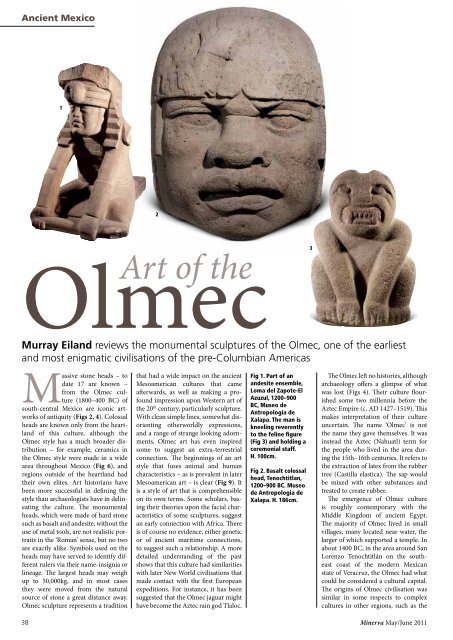Cult of beauty - Minerva
Cult of beauty - Minerva
Cult of beauty - Minerva
You also want an ePaper? Increase the reach of your titles
YUMPU automatically turns print PDFs into web optimized ePapers that Google loves.
Ancient Mexico<br />
Olmec<br />
Art <strong>of</strong> the<br />
Murray Eiland reviews the monumental sculptures <strong>of</strong> the Olmec, one <strong>of</strong> the earliest<br />
and most enigmatic civilisations <strong>of</strong> the pre-Columbian Americas<br />
Massive stone heads – to<br />
date 17 are known –<br />
from the Olmec culture<br />
(1800–400 BC) <strong>of</strong><br />
south-central Mexico are iconic artworks<br />
<strong>of</strong> antiquity (Figs 2, 4). Colossal<br />
heads are known only from the heartland<br />
<strong>of</strong> this culture, although the<br />
Olmec style has a much broader distribution<br />
– for example, ceramics in<br />
the Olmec style were made in a wide<br />
area throughout Mexico (Fig 6), and<br />
regions outside <strong>of</strong> the heartland had<br />
their own elites. Art historians have<br />
been more successful in defining the<br />
style than archaeologists have in delineating<br />
the culture. The monumental<br />
heads, which were made <strong>of</strong> hard stone<br />
such as basalt and andesite, without the<br />
use <strong>of</strong> metal tools, are not realistic portraits<br />
in the ‘Roman’ sense, but no two<br />
are exactly alike. Symbols used on the<br />
heads may have served to identify different<br />
rulers via their name-insignia or<br />
lineage. The largest heads may weigh<br />
up to 50,000kg, and in most cases<br />
they were moved from the natural<br />
source <strong>of</strong> stone a great distance away.<br />
Olmec sculpture represents a tradition 2<br />
38<br />
1<br />
2<br />
that had a wide impact on the ancient<br />
Mesoamerican cultures that came<br />
afterwards, as well as making a pr<strong>of</strong>ound<br />
impression upon Western art <strong>of</strong><br />
the 20 th century, particularly sculpture.<br />
With clean simple lines, somewhat disorienting<br />
otherworldly expressions,<br />
and a range <strong>of</strong> strange looking adornments,<br />
Olmec art has even inspired<br />
some to suggest an extra-terrestrial<br />
connection. The beginnings <strong>of</strong> an art<br />
style that fuses animal and human<br />
characteristics – as is prevalent in later<br />
Mesoamerican art – is clear (Fig 9). It<br />
is a style <strong>of</strong> art that is comprehensible<br />
on its own terms. Some scholars, basing<br />
their theories upon the facial characteristics<br />
<strong>of</strong> some sculptures, suggest<br />
an early connection with Africa. There<br />
is <strong>of</strong> course no evidence, either genetic<br />
or <strong>of</strong> ancient maritime connections,<br />
to suggest such a relationship. A more<br />
detailed understanding <strong>of</strong> the past<br />
shows that this culture had similarities<br />
with later New World civilisations that<br />
made contact with the first European<br />
expeditions. For instance, it has been<br />
suggested that the Olmec jaguar might<br />
have become the Aztec rain god Tlaloc.<br />
Fig 1. Part <strong>of</strong> an<br />
andesite ensemble,<br />
Loma del Zapote-El<br />
Azuzul, 1200–900<br />
BC, Museo de<br />
Antropologia de<br />
Xalapa. The man is<br />
kneeling reverently<br />
to the feline figure<br />
(Fig 3) and holding a<br />
ceremonial staff.<br />
H. 100cm.<br />
Fig 2. Basalt colossal<br />
head, Tenochtitlan,<br />
1200–900 BC. Museo<br />
de Antropologia de<br />
Xalapa. H. 186cm.<br />
3<br />
The Olmec left no histories, although<br />
archaeology <strong>of</strong>fers a glimpse <strong>of</strong> what<br />
was lost (Figs 4). Their culture flourished<br />
some two millennia before the<br />
Aztec Empire (c. AD 1427–1519). This<br />
makes interpretation <strong>of</strong> their culture<br />
uncertain. The name ‘Olmec’ is not<br />
the name they gave themselves. It was<br />
instead the Aztec (Nahuatl) term for<br />
the people who lived in the area during<br />
the 15th–16th centuries. It refers to<br />
the extraction <strong>of</strong> latex from the rubber<br />
tree (Castilla elastica). The sap would<br />
be mixed with other substances and<br />
treated to create rubber.<br />
The emergence <strong>of</strong> Olmec culture<br />
is roughly contemporary with the<br />
Middle Kingdom <strong>of</strong> ancient Egypt.<br />
The majority <strong>of</strong> Olmec lived in small<br />
villages, many located near water, the<br />
larger <strong>of</strong> which supported a temple. In<br />
about 1400 BC, in the area around San<br />
Lorenzo Tenochtitlán on the southeast<br />
coast <strong>of</strong> the modern Mexican<br />
state <strong>of</strong> Veracruz, the Olmec had what<br />
could be considered a cultural capital.<br />
The origins <strong>of</strong> Olmec civilisation was<br />
similar in some respects to complex<br />
cultures in other regions, such as the<br />
<strong>Minerva</strong> May/June 2011

















